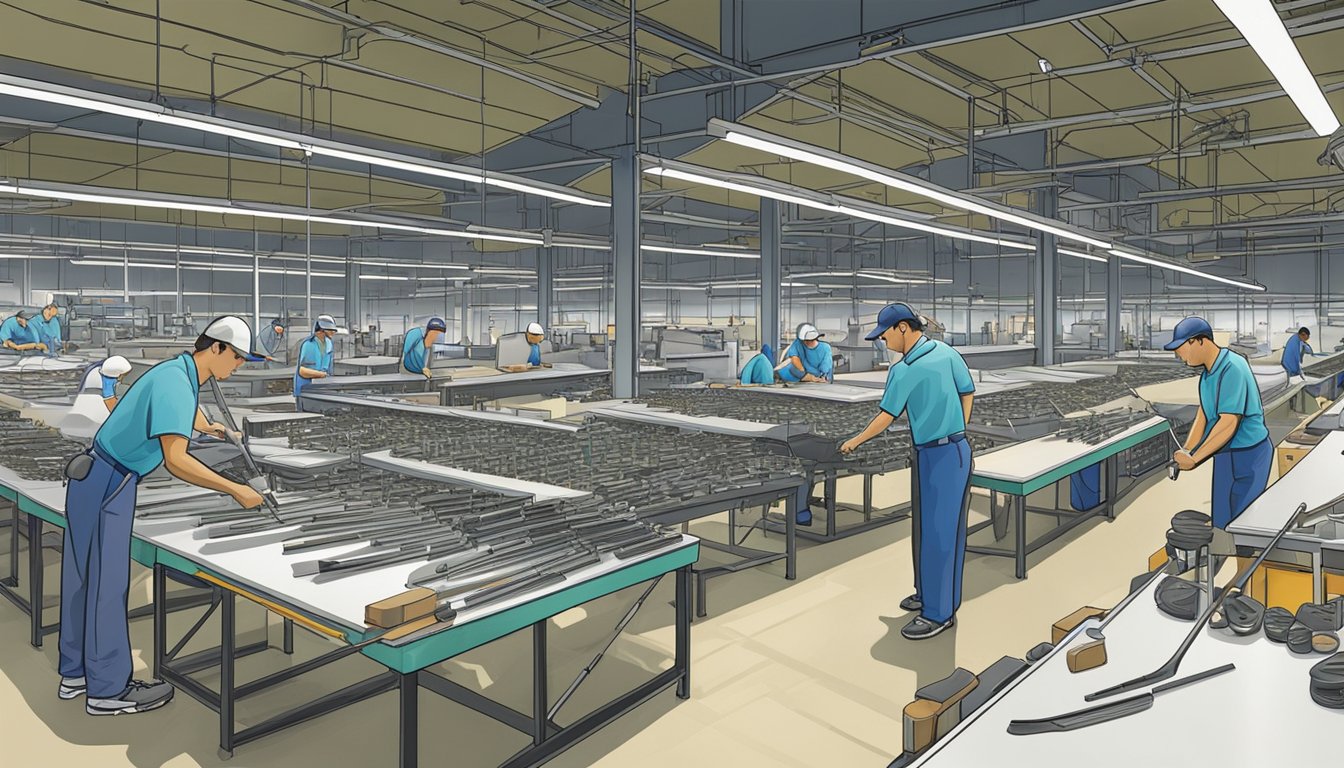If you’re a golf enthusiast, you’re probably familiar with the brand Ping. Ping is a renowned manufacturer of high-quality golf clubs and bags. However, you may be wondering where Ping golf clubs are made. In this article, we’ll explore the history and founding of Ping, the manufacturing process of Ping golf clubs, and the features and benefits of Ping golf clubs. We’ll also touch on Ping’s product range and answer some frequently asked questions about the brand.
Ping was founded in 1959 by Karsten Solheim, an engineer at General Electric. Solheim was a passionate golfer who was dissatisfied with the putters available on the market. He decided to create his own putter, which he named the Ping 1A. The Ping 1A was a huge success, and Solheim left his job at General Electric to focus on his new venture. Today, Ping is one of the most respected names in the golf industry, known for its innovative designs and commitment to quality.
When it comes to manufacturing, Ping takes great pride in its all-American roots. The company produces all of its golf clubs and bags in its Phoenix, Arizona factory. Ping has always been committed to using the highest quality materials and the latest technology to create golf clubs that perform at the highest level. Now that you know a little more about the history and manufacturing process of Ping golf clubs, let’s dive into the features and benefits that make Ping clubs so popular among golfers.
Key Takeaways
- Ping is a renowned manufacturer of high-quality golf clubs and bags.
- Ping was founded in 1959 by Karsten Solheim, an engineer at General Electric.
- Ping produces all of its golf clubs and bags in its Phoenix, Arizona factory.
History and Founding of Ping
https://www.youtube.com/watch?v=svMXvDLmeAQ&embed=true
Ping is a global leader in the golf industry, known for its high-quality equipment and innovative designs. The company was founded by Karsten Solheim, an engineer who worked at the General Electric company. In 1959, Solheim started making putters in his garage in Redwood City, California. He built his first putter and noticed it made a “ping” sound when it struck the ball, a discovery that inspired the name of his company.
Karsten Solheim’s Influence
Solheim’s engineering background was instrumental in the development of Ping’s innovative designs. He was passionate about creating golf clubs that would help golfers improve their game. Solheim’s legacy lives on today in the company’s commitment to innovation and quality.
Growth and Evolution of the Brand
Ping has come a long way since its origins as a garage business. Today, the company has a global presence and offers a full range of golf clubs and accessories. Ping’s commitment to quality and innovation has earned the brand a loyal following among professional and amateur golfers alike.
Major Championship Wins and Professional Endorsements
Ping’s reputation for quality and innovation has earned the brand numerous professional endorsements and major championship wins. Professional golfers such as Lee Westwood, Bubba Watson, and Louis Oosthuizen have all used Ping equipment to win major championships.
Ping Gold Putter Vault
Ping’s commitment to quality and innovation is reflected in its Gold Putter Vault, which houses some of the most iconic putters in golf history. The vault includes putters used by major championship winners and members of the World Golf Hall of Fame.
Ping’s Presence in Europe
Ping has a strong presence in Europe, with a dedicated European headquarters located in Gainsborough, England. The company’s commitment to quality and innovation has earned it a loyal following among European golfers.
Ping’s Presence in the United States
Ping’s headquarters are located in Phoenix, Arizona, where the company continues to innovate and develop new golf clubs and accessories. Ping’s commitment to quality and innovation has earned it a loyal following among American golfers.
In summary, Ping’s origins as a garage business in Redwood City, California, have evolved into a global brand known for its commitment to quality and innovation. The brand’s presence in Europe and the United States, as well as its numerous professional endorsements and major championship wins, are a testament to its ongoing success in the golf industry.
Manufacturing Process of Ping Golf Clubs
https://www.youtube.com/watch?v=dCMPYdPRwKI&embed=true
When it comes to the manufacturing process of Ping Golf Clubs, the company is known for its rigorous quality control and attention to detail. Ping Golf Clubs are designed and manufactured in-house in Phoenix, Arizona, where the company was founded in 1959.
Design and Innovation
Ping Golf Clubs are designed using computer-aided design (CAD) technology, which allows for precise and innovative club design. The company’s club designers review player feedback from all skill levels to ensure that each product meets player’s needs.
Materials and Construction
Ping Golf Clubs are made using a variety of materials, including steel, titanium, stainless steel, and aluminum. The materials are carefully selected to ensure the best possible performance and durability. The construction of Ping Golf Clubs is also carefully monitored to ensure consistency and precision.
Quality Control and Precision
Ping Golf Clubs undergo rigorous quality control measures to ensure that each club meets the company’s high standards. The company’s attention to detail ensures that each club is made with precision and consistency.
Custom Fitting System
Ping Golf Clubs also offer a custom fitting system, which allows golfers to get a club that is specifically tailored to their needs. The custom fitting system takes into account a golfer’s height, swing speed, and other factors to ensure that the club is the perfect fit.
In conclusion, Ping Golf Clubs are known for their innovative design, high-quality materials, rigorous quality control, and custom fitting system. If you’re looking for a golf club that is tailored to your needs and made with precision and attention to detail, Ping Golf Clubs are an excellent choice.
Features and Benefits of Ping Golf Clubs
https://www.youtube.com/watch?v=S-D-wUopPDE&embed=true
If you’re looking for high-quality golf clubs that can help you improve your game, then you should consider Ping golf clubs. Ping is a well-known brand in the golf industry, and they offer a wide variety of golf clubs that are designed to suit different skill levels. In this section, we’ll take a look at some of the features and benefits of Ping golf clubs.
Performance and Forgiveness
One of the main features of Ping golf clubs is their performance and forgiveness. Ping clubs are designed to help golfers achieve maximum distance, control, and accuracy. They are engineered to provide a consistent ball flight and trajectory, which can help golfers of all skill levels improve their game.
Durability and Trust
Another feature of Ping golf clubs is their durability and trust. Ping clubs are made from high-quality materials, which makes them durable and long-lasting. This means that you can trust your Ping clubs to perform well for years to come. Additionally, Ping offers a warranty on their clubs, which gives you added peace of mind.

Clubhead Speed and Feel
« Graphite vs Steel Golf Clubs Pros and Cons: Which is the Better Choice?
Nitro Crossfire Golf Balls Review: Are They Worth the Hype? »
Ping golf clubs are also designed to provide excellent clubhead speed and feel. The clubheads are engineered to be aerodynamic, which can help golfers achieve maximum clubhead speed. Additionally, the clubs are designed to provide a great feel, which can help golfers achieve better shots.
Variety for Different Skill Levels
Finally, Ping golf clubs offer a wide variety of clubs that are designed for different skill levels. Whether you’re an amateur or a professional golfer, you can find a set of Ping clubs that will suit your needs. Ping offers clubs for beginners, intermediate golfers, and advanced golfers, which means that you can find a set of clubs that will help you improve your game.
In summary, Ping golf clubs offer a range of features and benefits that can help golfers of all skill levels improve their game. From performance and forgiveness to durability and trust, Ping clubs are designed to provide golfers with the tools they need to succeed on the course. Additionally, Ping offers a wide variety of clubs that are designed for different skill levels, which means that you can find a set of clubs that will suit your needs.
Ping’s Product Range
https://www.youtube.com/watch?v=fxagKh2Siws&embed=true
If you’re looking for high-quality golf equipment, Ping is a brand that you can trust. The company has a wide range of products that cater to golfers of all skill levels. Here’s a breakdown of Ping’s product range:

Clubs
Ping offers a variety of clubs, including putters, irons, drivers, woods, and wedges. Each club is designed to help you improve your game and achieve your goals on the course. Ping’s clubs are known for their quality, durability, and performance. Whether you’re a beginner or a seasoned pro, you can find a club that suits your needs.
Shafts
Ping’s shafts are available in both steel and graphite. Steel shafts are known for their durability and consistency, while graphite shafts are lighter and can help you achieve greater swing speed. Ping’s shafts are designed to help you get the most out of your clubs.
Bags and Accessories
In addition to clubs and shafts, Ping also offers a range of golf bags and accessories. Their bags come in a variety of sizes and styles and are designed to make it easy to carry your clubs and other gear. Ping’s accessories include gloves, hats, and other items that can help you look and feel your best on the course.
Overall, Ping’s product range is designed to help golfers of all skill levels improve their game. With high-quality clubs, shafts, bags, and accessories, you can trust Ping to provide you with everything you need to succeed on the course.
Frequently Asked Questions

Where are PING golf clubs manufactured?
PING golf clubs are designed and manufactured in the United States, specifically in Phoenix, Arizona. PING has been making golf clubs in the USA since 1959, and they are known for their high-quality craftsmanship and attention to detail.
What is the history of PING golf clubs?
PING was founded in 1959 by Karsten Solheim, a Norwegian-born engineer who moved to the United States in the 1950s. Solheim started making putters in his garage and eventually expanded the business to include other golf clubs. PING has since become one of the most respected names in the golf industry, known for their innovative designs and commitment to quality.
Who founded PING golf?
PING was founded by Karsten Solheim, who started making putters in his garage in the late 1950s. Solheim’s innovative designs and commitment to quality helped PING become one of the most respected names in the golf industry.
What makes PING golf clubs special?
PING golf clubs are known for their innovative designs and commitment to quality. PING’s engineers use cutting-edge technology to create clubs that are both high-performing and easy to use. PING also offers a wide range of customization options, allowing golfers to tailor their clubs to their specific needs.
Where are Callaway golf clubs manufactured?
Callaway golf clubs are manufactured in a variety of locations around the world, including the United States, Mexico, and China. Callaway is one of the largest golf equipment manufacturers in the world, and they offer a wide range of clubs to suit golfers of all skill levels.
Where does PXG manufacture their clubs?
PXG manufactures their clubs in the United States, specifically in Arizona. PXG is known for their high-end, premium golf clubs, which are designed for serious golfers who demand the best. PXG’s clubs are known for their innovative designs and advanced technology, and they are some of the most expensive clubs on the market.









